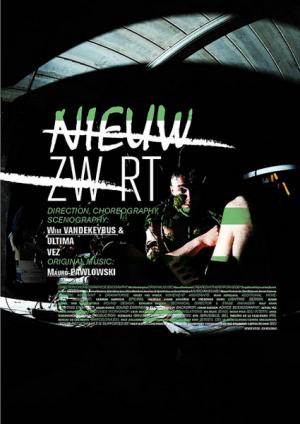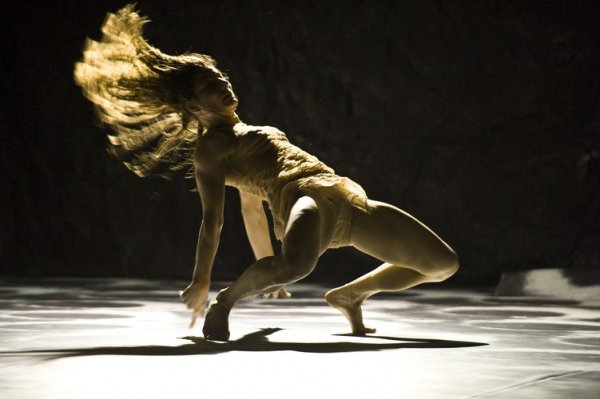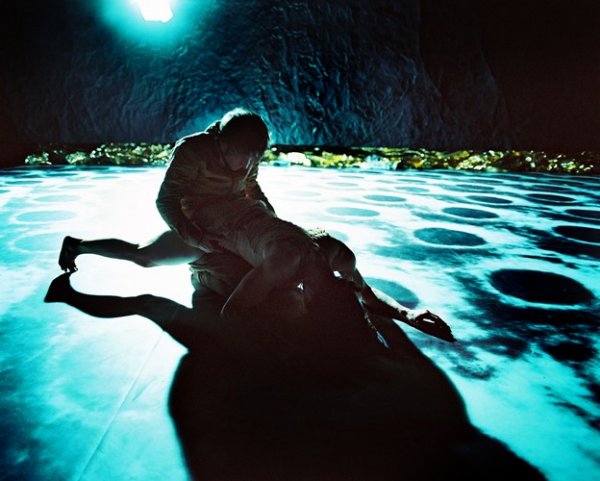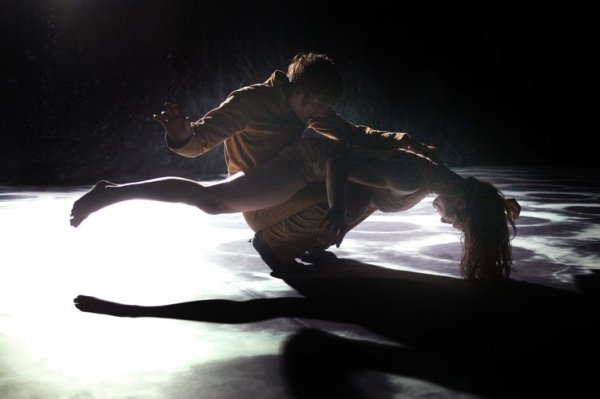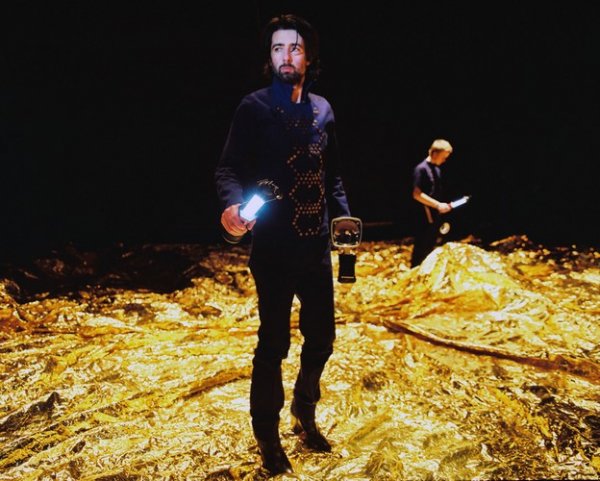Three types of language: word, music and movement...
Phrases building a story that bears a very strong and, at the same time, a somehow dark surrealistic touch...
Naked bodies revealed, sorrow and screaming springing out of them when meeting the light inspecting them, as if rays of sun are directly burning their skin.
This is the incipient picture of NieuwZwart, a performance created by Wim Vandekeybus for seven dancers, an actress and a suspended band (the music is lively performed all along the performance by Mauro Pawlowski, Elko Blijweert and Jeroen Stevens, on a platform hanging above the stage).
The words, the sounds and the movements interwine in order to build a story that should not be followed and understood according to its narrative structure, but to its capacity of breaking what we usually know about the meaning of the word, the function of the sound and the status of the contemporary body.
The three types of discourse cannot be analysed separately. There is a very carefully elaborated sense of balance in the synthesis operated between the text written by Peter Verhelst, the live music of Mauro Pawlowsky and the movement created by Wim Vandekeybus.
The gestures increasingly become more and more forceful, the bodies are involved in almost impossible movements (which, according to a paradigm of the text delievered by Kylie Walters could be labelled as "human or... otherwise").
Bodies getting born, suffering, clashing, gaining a very distinctive identity convey the feeling of a dream-like world, in which everything is shaped through the energy contained in the letters of each word, in the energy of each sound and in the tragic convulsion of gestures.
It would be very easy and first-hand to call this world violent. Even if the movement could seem violent, there is nothing about violence on the stage. It is about the natural call of a world that tries to surpass an usual condition and to set the human representation of the body on a new stage of perception.
The movement of each dancer merges gradually into typologies of gesture, each dancer becomes an easily recognizable presence who, after a complete cycle of movement and interaction with the others, falls back into the incipient status of the bodily condition. Then everything should start over again, with a new birth, a new explosion of sound and a new rain of meanings of the words.
We should not sink into the illusion of witnessing a live concert accompanying a dance performance paralleled by a story. The music acts like a form of energy that throws a stronger light upon the meaning of the bodily language, which seems to consequently give birth to the words and get born by the meanings in the text. The woman who tells us the story is "translated" into a moving script, but at the same time we can look from the opposite angle. We also have to avoid labelling the presences on the stage as real characters. They all stand for certain conditions that must be surpassed and elevated to another form of understanding. As contemporary beings, we are accustomed to move in a certain way designed by social codes, we speak in words suffocated within the walls of established meanings and we listen to the repetitive music of our "safe" habits.
All the dry repetitiveness of our nowadays condition is unmasked by Wim Vandekeybus in this performance: in order to escape the "warm" shelter of our redundancy, we have to experience a complete eclipse of the body, we must learn how to watch the movement beyond the human possibilities but, at the same time to integrate it in the world of our common perception.
The bodily language elaborated in Wim Vandekeybus' very personal style should be regarded beyond its spectacular quality and also beyond what might seem violent. It contains a very meaningful lyrism of force, a poetry of strength, it is a meeting between contraries that shapes the movement into a discourse that plees for jumping into a new sphere of understanding our very own condition as embodied beings.
Once we watched straight into the sun, we see a new black (nieuwzwart) horizon beyond which there is a new status of the human being that our eyes will gradually learn to get used to. And everything will fall back, and everything will be degraded again and crawl again to a new eclipse, to a new end/start. This is the eternal return of the struggle of the body to destroy and construct its condition. It is like the endless flow of things that Heraclitus pointed at in the pre-Socratic period, it is like the physical world described by Plato, a world that, once thrown into becoming and existence, though it looks like a supreme divine Idea, it must wither and disappear into the nothingness out of which it will get born again.
NieuwZwart
World première 9/05/2009 Mercat de les Flors, Barcelona
Direction, choreography, scenography: Wim Vandekeybus
Original music: Mauro Pawlowski
Created with & performed by: Tanja Marín Friðjónsdóttir, Dawid Lorenc, Bénédicte Mottart, Olivier Mathieu, Máté Mészáros, Ulrike Reinbott, Imre Vass and Kylie Walters
Musicians (live): Mauro Pawlowski, Elko Blijweert, Jeroen Stevens
Text: Peter Verhelst
Artistic assistant & dramaturge: Greet Van Poeck
Lighting design: Alban Rouge, Wim Vandekeybus
Photos: Josep Aznar and Pieter Jan de Pue
